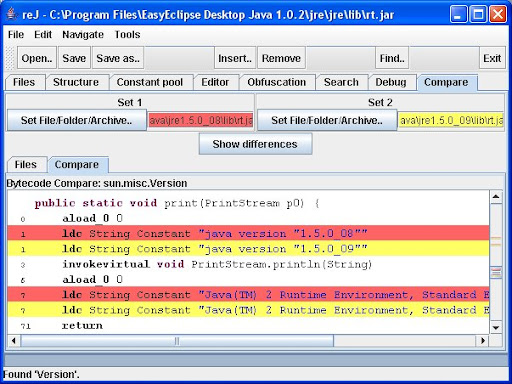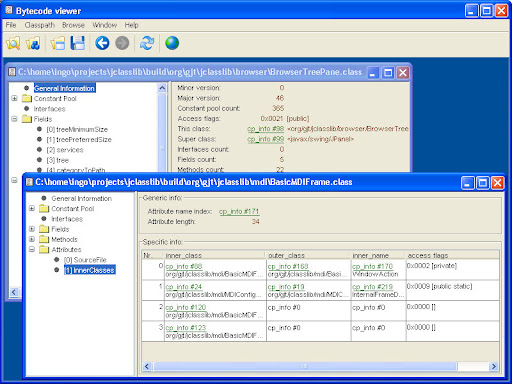reJ : what kind of bytecode inspection tool do you actually need ?
雖然我是個平常用不到 bytecode inspection tool 的人, 不過今天因緣際會看到 reJ 這個 tool, 起了一點想法.
我們對於什麼東西都可以用 5W1H, who, when, why, what, where, how 來嘗試弄清該東西的本質, 而我就想問了, what kind of bytecode inspection tool do you actually need ? 以及 who else also need this tool ?
reJ 這樣說了,
There are various robust libraries/APIs available for bytecode manipulation, such as:
- BCEL - http://jakarta.apache.org/bcel/
- ASM - http://asm.objectweb.org/
- Serp - http://serp.sourceforge.net/
關鍵句子出現了, "serve the needs of the user interface".
現在已經有很多強大的 bytecode manipulation library 出現, 尤其是 BCEL 跟 ASM, 基本上最近幾年在比較好的 software engineering conference / journal 上看到關於需要處理 bytecode 的 paper 都脫不了使用這兩個 tools. 在品質上顯然是受到信賴的.
然而 bytecode manipulation 終究只是技術的問題. 怎樣從 bytecode data 中挖出 information 並不該是身為 programmer 的我們需要花費最多關注的問題, 畢竟這是個一定可以被解決的問題. 我們更應該關注的是怎樣更有效率地挖出有意義的 information, 或者換句話說, bytecode inspection tool 要該要呈現什麼樣的 user interface 給 programmer, 才能夠讓 bytecode inspection 的動作有意義且有效率. 我相信 reJ 的那段話就是在嘗試說明此點.
User interface 在這裡並不單純指 software GUI 而已, 而是包含了 programmer 跟 bytecode inspection tool 之間的各種 operating languages. 透過 user interface 的設計, bytecode inspection tool 可以知道 programmer 真正想要的 information, 並且將之呈現給 programmer.
從 reJ 的 screeshots 可以看到這種努力, 雖然目前支援的 views 還很少, 但是這是以 service 的觀點來製作 bytecode inspection tool, 嘗試把 programmer 真正想要用的 views 帶進 software. (這不就是 service-oriented computing ?) 底下 screeshots 取自 reJ @ SourceForge.net.

 也有其他的 tool 有類似的想法, 例如 jclasslib, 可以看到的 information 更多, 但是過多的 information 卻沒有整理成適當的 views, 一樣對於 programmer 來說是種困擾. 底下是 jclasslib 的一張 screeshot, 其他的 screeshots 可以在他的網站找到.
也有其他的 tool 有類似的想法, 例如 jclasslib, 可以看到的 information 更多, 但是過多的 information 卻沒有整理成適當的 views, 一樣對於 programmer 來說是種困擾. 底下是 jclasslib 的一張 screeshot, 其他的 screeshots 可以在他的網站找到.
上午10:04
|
標籤:
IDE,
idea,
java,
reverse engineering,
service oriented computing
|
This entry was posted on 上午10:04
and is filed under
IDE
,
idea
,
java
,
reverse engineering
,
service oriented computing
.
You can follow any responses to this entry through
the RSS 2.0 feed.
You can leave a response,
or trackback from your own site.

0 意見:
張貼留言